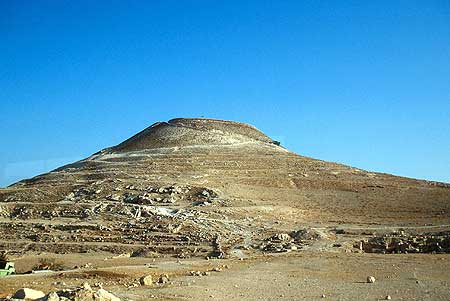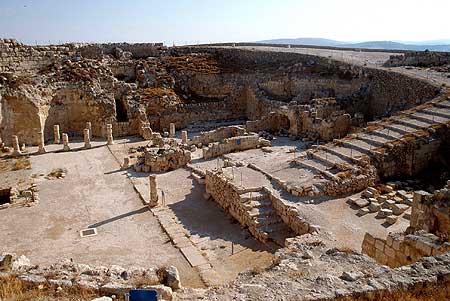
Based on a press release from the Hebrew University in Israel, the tomb of King Herod was discovered at the Herodium, one of Herod’s palace-fortresses bordering the Judean desert. King Herod — as known as “Herod the Great” — ruled Jewish Palestine for Rome from 37 to 4 BCE and is probably best know for his many building projects.
The announcement was leaked by the Israeli newspaper Haaretz. Here’s an excerpt from the Haaretz article:
The Hebrew University of Jerusalem announced Monday night that it has uncovered the grave and tomb of King Herod, who ruled Judea for the Roman empire from circa 37 BCE.
According to a press release from the Hebrew University, the news of the archaeological find at Herodium was to be announced Tuesday morning at a special news conference, and was to be kept secret until then, but the discovery by Haaretz of the story had led to the premature announcement.
The tomb was discovered by Hebrew University Professor Ehud Netzer, who is considered one of the leading experts on King Herod. Netzer has conducted archeological digs at Herodium since 1972 in an attempt to locate the grave and tomb.
….
The majority of researchers had believed that Herod was in fact buried at Herodium, based on the writings of the ancient Jewish historian Flavius Josephus, but multiple excavations at the site failed to locate the grave.
Netzer’s successful dig focused on a different part of the site than previous excavations, between the upper part of Herodium and the site’s two palaces.

This discovery was a long time in the coming. Josephus, in his Jewish Antiquites (book 17, chapter 8, paragraph 3), noted Herod’s burial at the Herodium, though archaeologists have been unable to locate the tomb until now. Here is the account from Josephus:
After this was over, they prepared for his funeral, it being Archelaus’s care that the procession to his father’s sepulcher should be very sumptuous. Accordingly, he brought out all his ornaments to adorn the pomp of the funeral. The body was carried upon a golden bier, embroidered with very precious stones of great variety, and it was covered over with purple, as well as the body itself; he had a diadem upon his head, and above it a crown of gold: he also had a scepter in his right hand. About the bier were his sons and his numerous relations; next to these was the soldiery, distinguished according to their several countries and denominations; and they were put into the following order: First of all went his guards, then the band of Thracians, and after them the Germans; and next the band of Galatians, every one in their habiliments of war; and behind these marched the whole army in the same manner as they used to go out to war, and as they used to be put in array by their muster-masters and centurions; these were followed by five hundred of his domestics carrying spices. So they went eight furlongs to Herodium; for there by his own command he was to be buried. And thus did Herod end his life.
Herod is noted in the New Testament in Matthew chapter two as the king responsible for the slaughter of the innocent children when Jesus was a child.
There is supposed to be a press conference Tuesday in which more details will be released.
(HT Bob Derrenbacker)

Pingback: Codex: Biblical Studies Blogspot » Blog Archive » King Herod’s Tomb: Some Pictures
Pingback: Herod's Tomb and Heliodorus Stele « Slice of Time